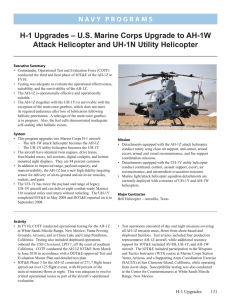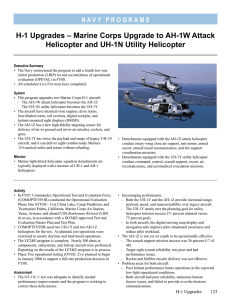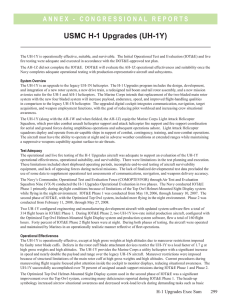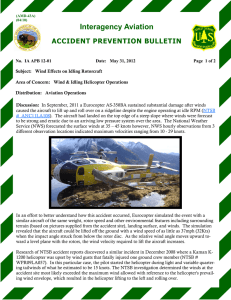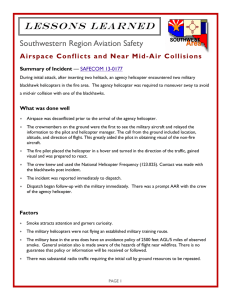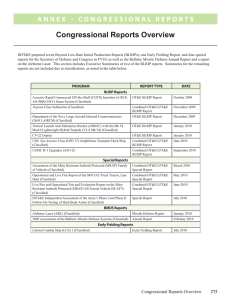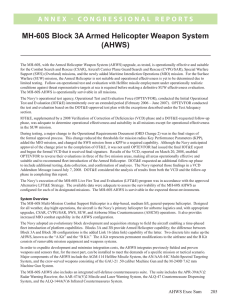H-1 Upgrades – U.S. Marine Corps Upgrade to AH-1W
advertisement
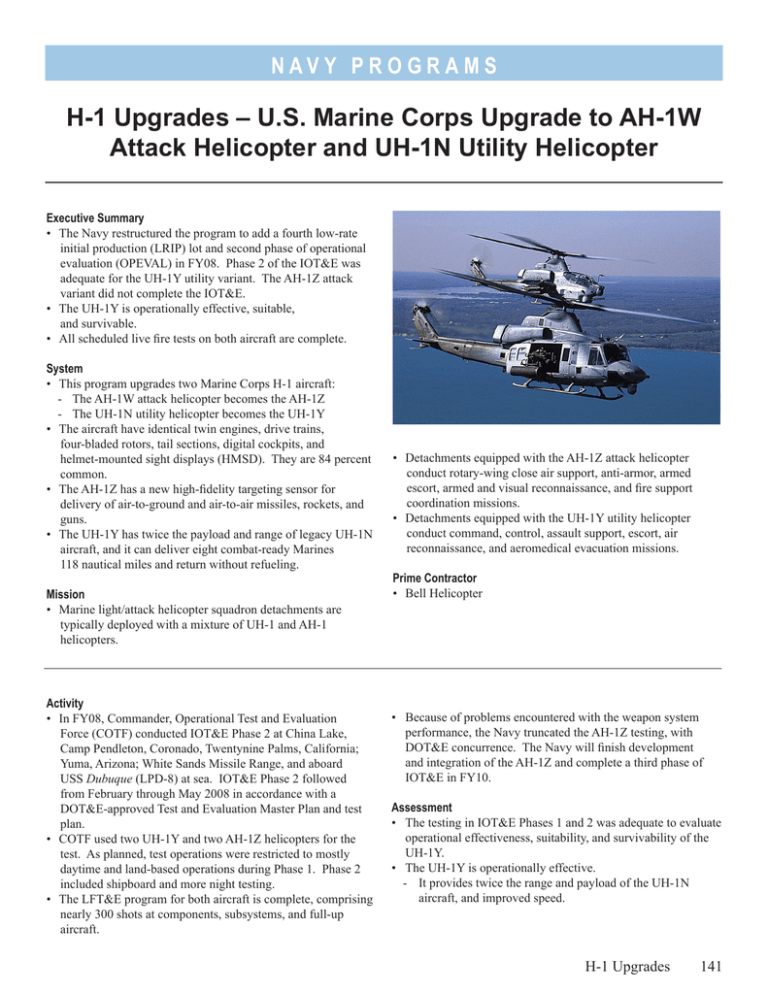
Na v y P RO G R A M S H-1 Upgrades – U.S. Marine Corps Upgrade to AH-1W Attack Helicopter and UH-1N Utility Helicopter Executive Summary • The Navy restructured the program to add a fourth low-rate initial production (LRIP) lot and second phase of operational evaluation (OPEVAL) in FY08. Phase 2 of the IOT&E was adequate for the UH-1Y utility variant. The AH-1Z attack variant did not complete the IOT&E. • The UH-1Y is operationally effective, suitable, and survivable. • All scheduled live fire tests on both aircraft are complete. System • This program upgrades two Marine Corps H-1 aircraft: - The AH-1W attack helicopter becomes the AH-1Z - The UH-1N utility helicopter becomes the UH-1Y • The aircraft have identical twin engines, drive trains, four-bladed rotors, tail sections, digital cockpits, and helmet-mounted sight displays (HMSD). They are 84 percent common. • The AH-1Z has a new high-fidelity targeting sensor for delivery of air-to-ground and air-to-air missiles, rockets, and guns. • The UH-1Y has twice the payload and range of legacy UH-1N aircraft, and it can deliver eight combat-ready Marines 118 nautical miles and return without refueling. Mission • Marine light/attack helicopter squadron detachments are typically deployed with a mixture of UH-1 and AH-1 helicopters. Activity • In FY08, Commander, Operational Test and Evaluation Force (COTF) conducted IOT&E Phase 2 at China Lake, Camp Pendleton, Coronado, Twentynine Palms, California; Yuma, Arizona; White Sands Missile Range, and aboard USS Dubuque (LPD-8) at sea. IOT&E Phase 2 followed from February through May 2008 in accordance with a DOT&E‑approved Test and Evaluation Master Plan and test plan. • COTF used two UH-1Y and two AH-1Z helicopters for the test. As planned, test operations were restricted to mostly daytime and land-based operations during Phase 1. Phase 2 included shipboard and more night testing. • The LFT&E program for both aircraft is complete, comprising nearly 300 shots at components, subsystems, and full-up aircraft. • Detachments equipped with the AH-1Z attack helicopter conduct rotary-wing close air support, anti-armor, armed escort, armed and visual reconnaissance, and fire support coordination missions. • Detachments equipped with the UH-1Y utility helicopter conduct command, control, assault support, escort, air reconnaissance, and aeromedical evacuation missions. Prime Contractor • Bell Helicopter • Because of problems encountered with the weapon system performance, the Navy truncated the AH-1Z testing, with DOT&E concurrence. The Navy will finish development and integration of the AH-1Z and complete a third phase of IOT&E in FY10. Assessment • The testing in IOT&E Phases 1 and 2 was adequate to evaluate operational effectiveness, suitability, and survivability of the UH-1Y. • The UH-1Y is operationally effective. - It provides twice the range and payload of the UH-1N aircraft, and improved speed. H-1 Upgrades 141 Na v y P RO G R A M S - The UH-1Y essentially met the planning goal for utility helicopter mission success (73 percent attained versus 75 percent goal). - The UH-1Y successfully completed all required types of missions. - The UH-1Y is not operationally effective at very high gross weights when operating above 6,000 feet density altitude because of maneuver restrictions imposed to avoid structural failure in the rotor blade attaching cuffs. - A 571-pound weight restriction on the mounting points for the Improved Defensive Armament System (IDAS) limits the number of rockets or the amount of external fuel the aircraft can carry. The IDAS itself is rated for 1,000 pounds. The IDAS limits the field of fire in order to prevent the defensive gun from impacting the external fuel tanks. The field of fire is limited whether the tanks are present or not. • The UH-1Y is operationally suitable. - It exceeded reliability thresholds for mean flight hours between failure and mean flight hours between abort. The UH-1Y requires less unscheduled maintenance but slightly more overall maintenance than the UH-1N. - Deficiencies in the design of the rotor blade attaching cuffs causes cuff replacement in the UH-1Y at less than one-tenth of the planned service life of these components. • Deficiencies for both aircraft include the following: - Poor helmet performance limits operations in the expected low-light operational conditions. - Both aircraft had poor reliability, numerous human factors issues, and failed to provide over-the-horizon communications. 142 H-1 Upgrades - The paucity of repair parts delayed replacement of composite rotor system components in the supply system. - Main rotor gearbox vulnerability to certain ballistic impacts did not meet requirements. • Deficiencies unique to the AH-1Z include: - AH-1Z target sight system reliability was poor and had performance deficiencies. - AH-1Z rocket and Hellfire missile delivery was not effective. Recommendations • Status of Previous Recommendations. The program is making satisfactory progress complying with the FY07 recommendations. • FY08 Recommendations. The Navy should: 1. Plan AH-1Z IOT&E Phase 3 to complete required OT&E. Phase 3 should include the following: ▪ Ship-based operations, to include take-off and landing in low light levels ▪ Assault support operations, with the majority of those operations taking place at night ▪ Improved instrumentation for evaluation of gun and rocket engagement accuracy ▪ Adequate numbers of flight hours to evaluate aircraft reliability 2. Mitigate the flight restrictions for firing rockets from the AH-1Z. 3. Increase the load capacity of the IDAS, and expand the gun field of fire. 4. Improve the main rotor gearbox and test it in additional LFT&E.
